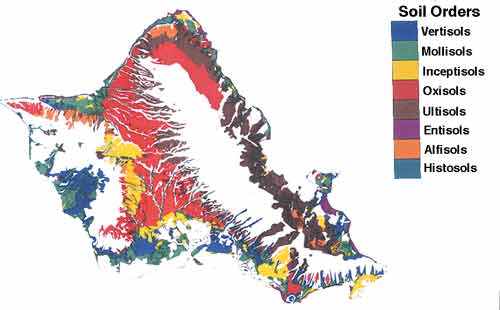THE NATURAL ENVIRONMENT
Geography 101
ToC
WATER
Cycle
Balance
Water In
Water Out
Soil
Classify
Soil Classification
|
|
BOX 1 |
In the previous section, we discussed several of the basic properties of soils. Around the world, these properties occur in limitless combinations making soil classification nearly as complex and extensive as classifying living organisms. In the United States, the Soil Conservation Service (SCS) has attempted to categorize the entire country in painstaking detail. Their information provides invaluable baseline data for practical agriculture and environmental research.
Soils are classified using a hierarchical system, descending from general to specific through orders, suborders, great groups, subgroups, and families to the lowest level, the individual soil series. Each order contains many suborders, each suborder contains many great groups, and so on. At the highest level in the SCS soil classification system for the United States are 12 Soil Orders, most of which are represented in Hawai'i, as shown in the O'ahu soils map below. We will briefly discuss four of them.

 Those
red clay soils that you see in central O'ahu and other locations are primarily Oxysols.
These are tropical soils that form in areas of high rainfall and temperature.
In general, they are not very fertile because weathering and eluviation deplete
them of nutrients. The red color arises from oxides
of iron
that remain
near the surface after other elements have washed away. Oxysols are common
in the tropics and often form an extremely hard, cement like layer in
the B horizon called laterite. Unfortunately, hundreds
of millions of farmers in tropical countries depend on these nutrient-poor
soils, whose
fertility is declining even more as deforestation and poor farming practices
leave the thin topsoil layer bare to erosion. The prefix oxy- refers to
the concentration of oxidized iron and often aluminum as well.
Those
red clay soils that you see in central O'ahu and other locations are primarily Oxysols.
These are tropical soils that form in areas of high rainfall and temperature.
In general, they are not very fertile because weathering and eluviation deplete
them of nutrients. The red color arises from oxides
of iron
that remain
near the surface after other elements have washed away. Oxysols are common
in the tropics and often form an extremely hard, cement like layer in
the B horizon called laterite. Unfortunately, hundreds
of millions of farmers in tropical countries depend on these nutrient-poor
soils, whose
fertility is declining even more as deforestation and poor farming practices
leave the thin topsoil layer bare to erosion. The prefix oxy- refers to
the concentration of oxidized iron and often aluminum as well.
The Ultisols along the windward coast form similarly to Oxysols, but in a wetter climate. They are often reddish in color, but even more deeply weathered and leached of nutrients than Oxysols, and tend to be acidic. Under natural conditions, Ultisols underlay forests. When the forests are cleared, they, like the Oxysols, may lose fertility quickly through erosion of the thin topsoil layer. The prefix ulti- refers to these soils as having reached their "ultimate" state of development.
 Inceptisols are
young soils that have not yet formed distinct horizons. In Hawai'i, these
generally result from
volcanic ash deposits,
such as the Diamond Head and Koko Head areas. Inceptisols
may be fertile if watered, as weathering has not yet depleted nutrients.
Incept- refers to "beginning" soils.
Inceptisols are
young soils that have not yet formed distinct horizons. In Hawai'i, these
generally result from
volcanic ash deposits,
such as the Diamond Head and Koko Head areas. Inceptisols
may be fertile if watered, as weathering has not yet depleted nutrients.
Incept- refers to "beginning" soils.
 Vertisols in
Hawai'i are often found over marine deposits laid down when sea levels
were higher than today, such as Ewa Plain. They
tend to occur in
drier areas, have a high percentage of clay, and are prone to swelling
and cracking when they wet and dry out. This characteristic makes them
difficult to farm, even though they may be fertile. The swelling and cracking
cycle
may also cause infrastructure problems, such as fracturing highways and
moving houses off of their foundations. Vert- refers to swelling clays.
Vertisols in
Hawai'i are often found over marine deposits laid down when sea levels
were higher than today, such as Ewa Plain. They
tend to occur in
drier areas, have a high percentage of clay, and are prone to swelling
and cracking when they wet and dry out. This characteristic makes them
difficult to farm, even though they may be fertile. The swelling and cracking
cycle
may also cause infrastructure problems, such as fracturing highways and
moving houses off of their foundations. Vert- refers to swelling clays.